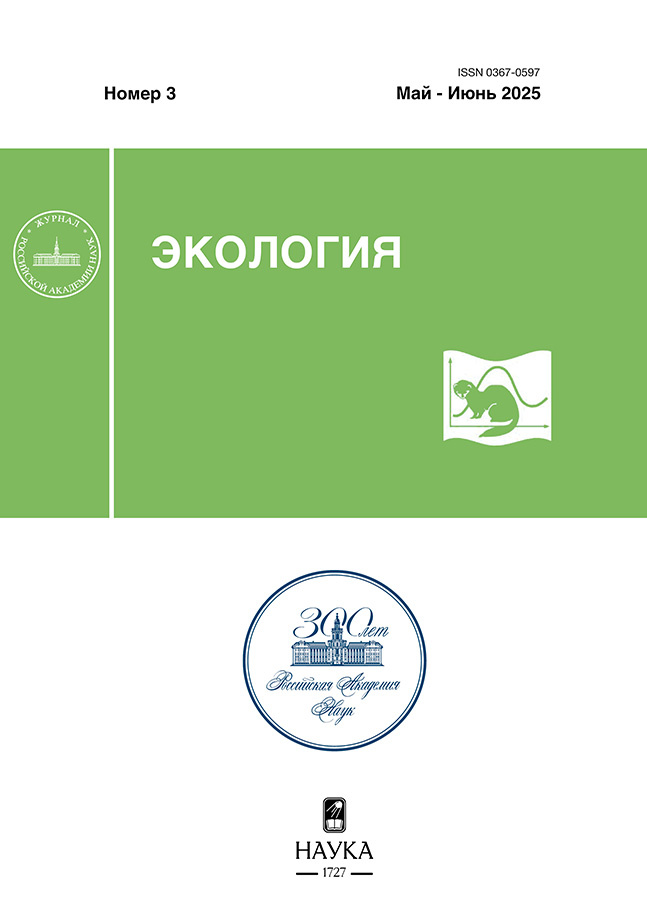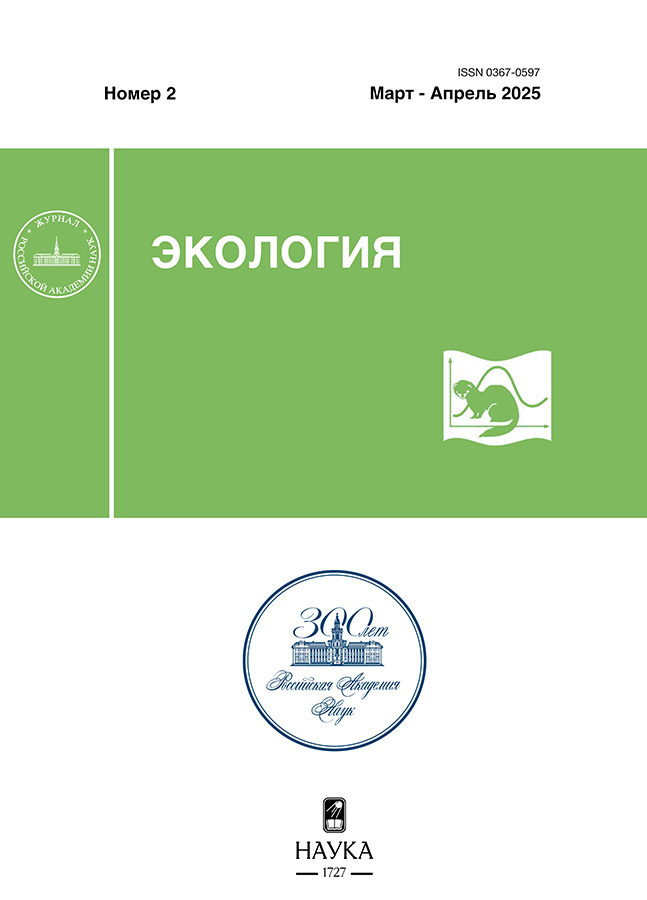Radial growth response of scots pine (Pinus sylvestris) to a gradient of radioactive contamination
- Authors: Modorov M.V.1, Kukarskikh V.V.1
-
Affiliations:
- Institute of Plant and Animal Ecology of the Ural Branch of the Russian Academy of Sciences
- Issue: No 2 (2025)
- Pages: 115-126
- Section: Articles
- URL: https://kld-journal.fedlab.ru/0367-0597/article/view/682257
- DOI: https://doi.org/10.31857/S0367059725020035
- EDN: https://elibrary.ru/TZNKSS
- ID: 682257
Cite item
Abstract
The annual rings of pine trees show a notable response to high doses of ionizing radiation, making the development of “dose-response models of radial growth” a compelling area of study. This research analyzed the radial growth of 50 common pine trees in the East-Ural Radioactive Trace (EURS), an area contaminated by the 1957 Kyshtym accident. Cores from 34 trees growing in two sites with minimal radioactive contamination served as a control group. A decline in the radial growth index of pines within the EURS zone was observed from 1959 to 1962, corresponding to 2–5 years after the accident. The severity of this decrease was directly proportional to soil contamination density with 90Sr at the trees’ location. The zone where the radial growth response was detected was narrow, approximately 300 m wide. The range of initial dose rates to pine meristems that elicited a response varied from 0.62 to 4.23 Gy per day—a range of less than one order of magnitude. Trees exposed to higher doses perished, while those exposed to lower doses exhibited radial growth comparable to that of control plots. The strongest model linking pine radial growth index to radioactive contamination density at the tree trunk used the average growth index for 1959—1960, with a linear regression model achieving a coefficient of determination (R2) of 0.69.
Full Text
About the authors
M. V. Modorov
Institute of Plant and Animal Ecology of the Ural Branch of the Russian Academy of Sciences
Author for correspondence.
Email: voloduke@mail.ru
Russian Federation, 202, March 8 St., Yekaterinburg, 620144
V. V. Kukarskikh
Institute of Plant and Animal Ecology of the Ural Branch of the Russian Academy of Sciences
Email: voloduke@mail.ru
Russian Federation, 202, March 8 St., Yekaterinburg, 620144
References
- Гродзинский Д.М. Радиобиология растений. Киев: Наукова думка, 1989. 380 c.
- Geras’kin S. Plant adaptation to ionizing radiation: Mechanisms and patterns // Science of the Total Environment. 2024. V. 916. Art. 170201. https://doi.org/10.1016/j.scitotenv.2024.170201
- Woodwell G.M., Miller L.N. Chronic gamma radiation affects the distribution of radial increment in pinus rigida stems // Science. 1963. V. 139. № 3551. P. 222–223. https://doi.org/10.1126/science.139.3551.222
- Bostrack J.M., Sparrow A.H. Effects of chronic gamma irradiation on the anatomy of vegetative tissues of pinus rigida mill // Radiation Botany. 1969. V. 9. № 5. P. 367–374. https://doi.org/10.1016/s0033-7560(69)80063-3
- Karaban’ R., Mishenkov N.N., Prister B.S. et al. Effects of acute gamma radiation on forest biogeocenosis // Proceedings of the Institute of Applied Geophysics: Problems of forest radioecology. 1979. № 38. P. 27–52.
- Tikhomirov F.A., Shcheglov A.I. Main investigation results on the forest radioecology in the Kyshtym and Chernobyl accident zones // The Science of the Total Environment. 1994. V. 157. P. 45–57. https://doi.org/10.1016/0048-9697(94)90564-9
- Мусаев Е.К. Сезонный рост и строение годичных колец сосны обыкновенной в зоне Чернобыльской катастрофы // Лесоведение. 1996. № 1. С. 16–28.
- Алексахин Р.М., Булдаков Л.А., Губанов В.А. и др. Крупные радиационные аварии: последствия и защитные меры. M.: ИздАТ, 2001. 752 с.
- Holiaka D., Fesenko S., Kashparov V. et al. Effects of radiation on radial growth of Scots pine in areas highly affected by the Chernobyl accident // J. Environmental Radioactivity. 2020. V. 222. Art. 106320. https://doi.org/10.1016/j.jenvrad.2020.106320
- Netsvetov M., Prokopuk Y., Holiaka D. et al. Is there Chornobyl nuclear accident signature in Scots pine radial growth and its climate sensitivity? // Science of the Total Environment. 2023. V. 878. Art. 163132.11. https://doi.org/10.1016/J.SCITOTENV.2023.163132
- Fesenko S., Spiridonov S., Geras’kin S. Radiation effects in the forest ecosystems: Acute irradiation // J. Environmental Radioactivity. 2022. V. 250. Art. 106908. https://doi.org/10.1016/j.jenvrad.2022.106908
- Kukarskih V. V., Modorov M.V., Devi N.M. et al. Radial growth of Pinus sylvestris in the East Ural Radioactive Trace (EURT): Climate and ionizing radiation // Science of the Total Environment. 2021. V. 781. Art. 146827. https://doi.org/10.1016/j.scitotenv.2021.146827
- Kukarskih V.V., Komarova A.V., Vakhrusheva A.D. et al. Indication of radioactive contamination of forest ecosystems in the zone of the East Ural Radioactive Trace using methods of quantitative wood anatomy // Russ. J. of Ecology. 2024. V. 55. № 3. P. 159–165. https://doi.org/10.1134/S1067413624700012
- Мусаев Е.К. Влияние радиационного поражения на годичные кольца сосны в районе Чернобыльской АЭС // Лесоведение. 1993. Т. 4. С. 41–49.
- Козлов В.А. Особенности прироста древесины по радиусу ствола у основных лесообразующих пород в районе аварии на Чернобыльской АЭС : Автореф. дис. ... канд. биол. наук. Сыктывкар, 1996. 22 c.
- Skuterud L., Goltsova N.I., Naumann R. et al. Histological changes in Pinus sylvestris L. in the proximal-zone around the Chernobyl power plant // Science of the Total Environment. 1994. V. 157. № 1–3. P. 387–397. https://doi.org/10.1016/0048-9697(94)90602-5
- Mousseau T.A., Welch S.M., Chizevsky I. et al. Tree rings reveal extent of exposure to ionizing radiation in Scots pine Pinus sylvestris // Trees-Structure and Function. 2013. V. 27. № 5. P. 1443–1453. https://doi.org/10.1007/s00468-013-0891-z
- Schmitt U., Grünwald C., Eckstein D. Xylem structure in pine trees grown near the Chernobyl Nuclear Power Plant/Ukraine // IAWA Journal. 2000. V. 21. № 4. P. 379–387. https://doi.org/10.1163/22941932-90000254
- Molchanova I., Mikhailovskaya L., Antonov K. et al. Current assessment of integrated content of longlived radionuclides in soils of the head part of the East Ural Radioactive Trace // J. Environmental Radioactivity. 2014. V. 138. № 6. P. 238−248. https://doi.org/10.1016/j.jenvrad.2014.09.004
- Nikipelov B.V., Romanov G.N., Buldakov L.A. et al. A radiation accident in the Southern Urals in 1957 // Soviet Atomic Energy. 1989. V. 67. P. 569–576.
- Pozolotina V.N., Shalaumova Y.V., Lebedev V.A. et al. Forests in the East Ural Radioactive Trace: structure, spatial distribution, and the 90Sr inventory 63 years after the Kyshtym accident // Environmental Monitoring and Assessment. 2023. V. 195. № 6. P. 1–13. https://doi.org/10.1007/S10661-023-11300-Y
- Тихомиров Ф.А., Карабань Р.Т. Радиационное поражение леса в условиях радиоактивного загрязнения // Экологические последствия радиоактивного загрязнения на Южном Урале / Под ред. Соколова В.Е., Криволуцкого Д.А. М.: Наука, 1993. C. 85–95.
- Атлас Восточно-Уральского и Карачаевского радиоактивных следов, включая прогноз до 2047 года / Под ред. Израэля Ю.А.. М.: ИГКЭ Росгидромета и РАН. Фонд «Инфосфера», НИА «Природа», 2013. 140 с.
- Rinn F. Tsap V 3.6 Reference manual: computer program for tree-ring analysis and presentation. Heidelberg, Germany: Bierhelder weg 20, D-69126. 1996. 263 p.
- Holmes R.L. Computer‐assisted quality control in tree‐ring dating and measurement // Tree-Ring Bulletin. 1983. V. 43. P. 69–78.
- Grissino-Mayer H.D. Evaluating crossdating accuracy: A manual and tutorial for the computer program COFECHA // Tree-Ring Research. 2001. V. 57. № 2. P. 205–221.
- Cook E.R., Peters K. The smoothing spline: A new approach to standardizing forest interior tree-ring width series for dendroclimatic studies // Tree-Ring Bulletin. 1981. V. 41. P. 45–53.
- Alexakhin R.M., Karaban’ R.T., Prister B.S. et al. The effects of acute irradiation on a forest biogeocenosis; experimental data, model and practical applications for accidental cases // Science of the Total Environment. 1994. V. 157. P. 357–369. https://doi.org/10.1016/0048-9697(94)90599-1
- Тихомиров Ф.А., Романов Г.Н. Дозы облучения организмов в условиях радиоактивного загрязнения леса // Экологические последствия радиоактивного загрязнения на Южном Урале / Под ред. Соколова В.Е., Криволуцкого Д.А. М.: Наука, 1993. С. 13–20.
- Modorov M., Seleznev A., Mikhailovskaya L. Heterogeneity of 90Sr radioactive contamination at the head part of the East Ural radioactive trace (EURT) // J. Environmental Radioactivity. 2017. V. 167. P. 117–126. https://doi.org/10.1016/J.JENVRAD.2016.11.019
- R Core Team. R: A Language and Environment for Statistical Computing. 2022.
- Mikhailovskaya L.N., Modorov M.V., Pozolotina V.N. et al. Heterogeneity of soil contamination by 90Sr and its absorption by herbaceous plants in the East Ural Radioactive Trace area // Science of the Total Environment. 2019. V. 651. P. 2345–2353. https://doi.org/10.1016/j.scitotenv.2018.10.119
- Yoschenko V.I., Kashparov V.A., Melnychuk M.D. et al. Chronic irradiation of Scots pine trees (Pinus sylvestris) in the Сhernobyl exclusion zone: Dosimetry and radiobiological effects // Health Physics. 2011. V. 101. № 4. P. 393–408. https://doi.org/10.1097/HP.0b013e3182118094
- Holiaka D., Yoschenko V., Cherniaiev O. R. et al. Variability of activity concentrations and radial distributions of 137Cs and 90Sr in trunk wood of Scots pine and Silver birch // J. Environmental Radioactivity. 2023. V. 263. Art. 107186. https://doi.org/10.1016/J.JENVRAD.2023.107186
Supplementary files













